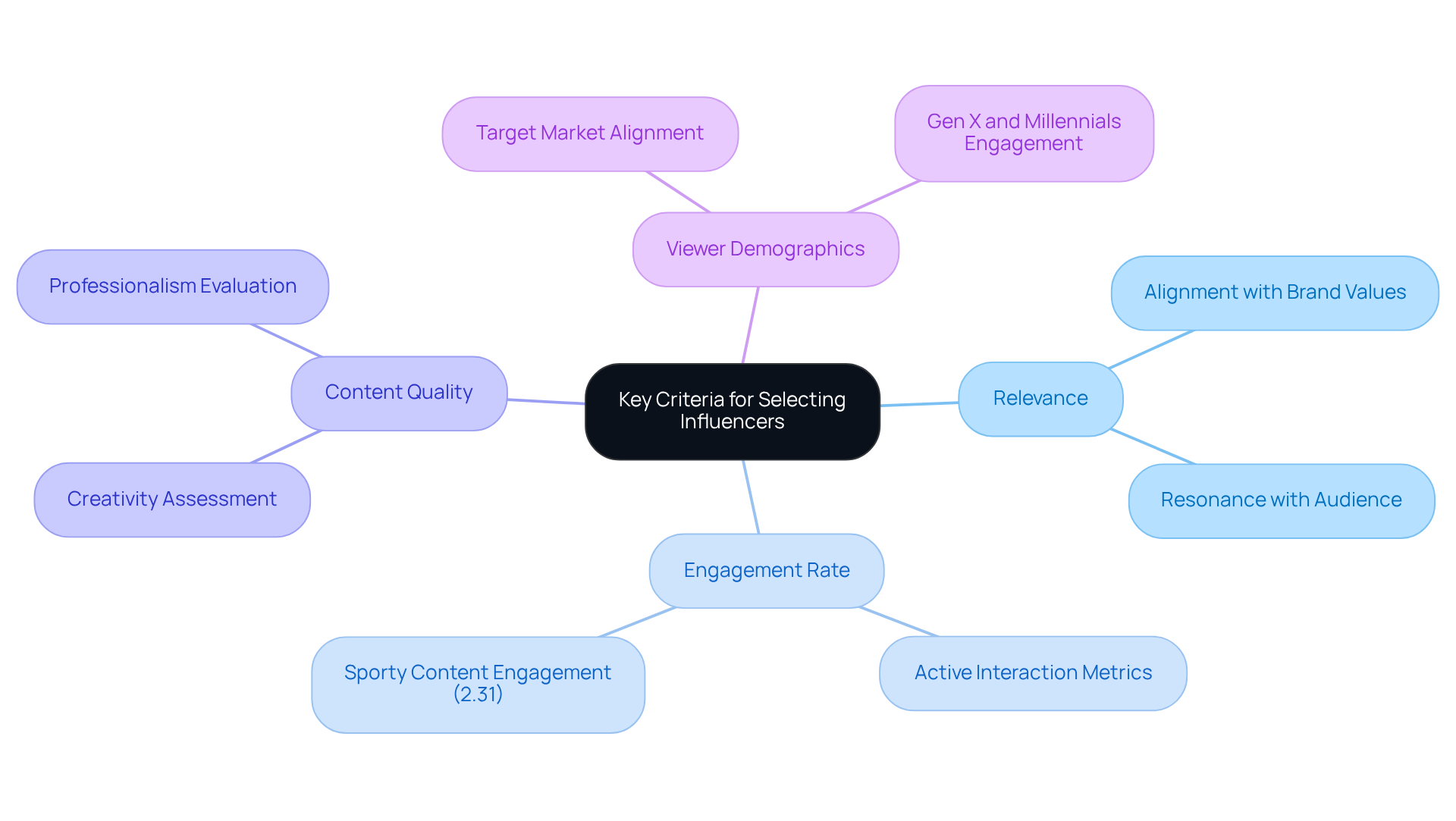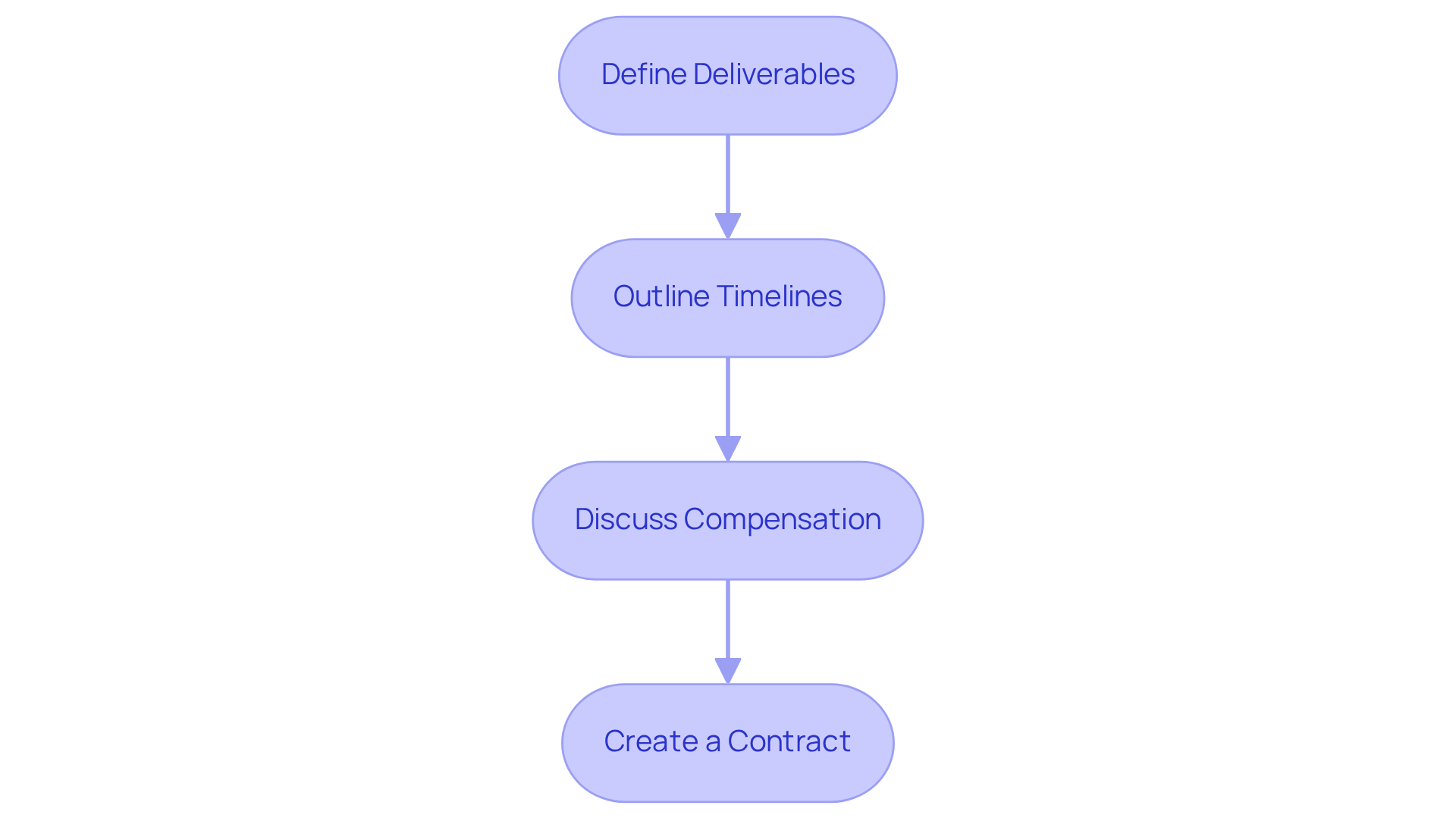
Introduction
The rise of influencer marketing has fundamentally transformed how brands connect with consumers, especially on platforms like YouTube, where authenticity and engagement reign supreme. This multi-billion-dollar industry is not just a trend; it’s a pivotal shift in marketing strategy. As brands navigate this evolving landscape, they face a critical challenge: how to effectively hire the right influencers who can amplify their message and foster genuine connections with their target audience.
What strategies can brands employ to successfully navigate this intricate terrain? By understanding the nuances of influencer partnerships, brands can ensure their collaborations resonate deeply with viewers, driving engagement and loyalty. It's time to explore how to harness the power of influencer marketing to create impactful connections.
Understand Influencer Marketing Basics
To effectively promote products or services, brands often engage in influencer promotion by choosing to hire YouTube influencers who have substantial followings on the platform. This approach often yields engagement rates that surpass those of conventional advertising techniques, as influencers create content that resonates deeply with their followers. The promotion sector is projected to reach a staggering $47.8 billion, underscoring its growing significance for brands. It's crucial for brands to recognize that marketing through social figures transcends mere reach; it focuses on cultivating authentic relationships with the right audience.
Understanding the landscape of social media personalities is vital, particularly the distinctions between macro, micro, and nano-influencers. Macro-influencers typically command large followings, while micro-influencers (1,000 to 100,000 followers) and nano-influencers (under 10,000 followers) often nurture more engaged and niche audiences. Brands that leverage nano-influencers can reap the benefits of their high engagement rates and genuine connections, as these creators are perceived as more relatable and trustworthy.
Furthermore, the trend toward authenticity is paramount; consumers are increasingly discerning and can readily identify inauthentic endorsements. Brands that hire YouTube influencers to authentically experience their products before promotion can significantly enhance credibility and foster trust. NugVerse plays a pivotal role in facilitating these collaborations by connecting brands with trusted creators who respect their craft, ensuring fair compensation for their work. As the landscape evolves, integrating current trends such as augmented reality and live-streaming into promotional campaigns can further boost engagement and provide real-time feedback on consumer preferences. By partnering with individuals who embody transparency and authenticity, brands can adeptly navigate the complexities of these collaborations, ensuring that their marketing strategies resonate in today's dynamic environment.

Identify Key Criteria for Selecting Influencers
When selecting influencers, brands must consider several key criteria that can significantly impact their marketing strategies:
-
Relevance: It's essential to ensure that the creator's material aligns with your brand values and resonates with your intended audience. This alignment is crucial for authentic engagement and effective brand representation.
-
Engagement Rate: Don't just look at follower counts; assess how actively the individual interacts with their followers through likes, comments, and shares. For instance, sporty content on Instagram achieved an impressive engagement rate of 2.31% in 2023, with 17.8 million posts highlighting its effectiveness and the importance of active audience participation.
-
Content Quality: Review the creator's previous work to evaluate their creativity and professionalism. High-quality content not only attracts viewers but also fosters trust and credibility, which are vital for successful partnerships.
-
Viewer Demographics: Examine the creator's followers to ensure they align with your target market. Tools like social media analytics can provide valuable insights into audience age, gender, and interests. Notably, Gen X and Millennials are nearly twice as likely to engage on Instagram compared to Boomers, according to the 2024 Influencer Marketing Report. Understanding this demographic landscape is essential for effective engagement.
By concentrating on these criteria, brands can hire YouTube influencers to make informed choices that enhance their marketing strategies and drive significant engagement. Are you ready to elevate your influencer marketing game?

Engage and Communicate with Influencers
To effectively engage with influencers, especially when you hire YouTube influencers, start by reaching out through their preferred communication channels, which are usually found in their social media bios or websites.
-
Personalize Your Message: Avoid generic outreach. Instead, reference specific content that resonates with you, showcasing your genuine interest in their work. This approach not only captures attention but also builds a connection.
-
Be clear about your intentions: Clearly articulate your collaboration goals and outline the mutual benefits of the partnership when you hire YouTube influencers. This transparency fosters trust and sets a positive tone for the relationship, making it easier for influencers to see the value in working together.
-
Discuss Collaboration Ideas: Present initial concepts on how the influencer can seamlessly incorporate your product into their content. This allows for creative freedom, encouraging them to envision how your product fits into their narrative.
-
Be Open to Feedback: Recognize that influencers possess a deep understanding of their audience. Be receptive to their insights and suggestions; this partnership can lead to more genuine and engaging content that resonates with their followers.

Set Clear Expectations and Agreements
Once you've engaged an influencer, setting clear expectations is paramount.
- Define Deliverables: Clearly specify the expected material, such as the number of videos, posts, or stories. This clarity ensures both parties are aligned from the start.
- Outline Timelines: Agree on deadlines for content creation and publication. Timelines help maintain momentum and accountability throughout the partnership.
- Discuss Compensation: Transparency about payment terms is essential. Whether it involves monetary compensation, free products, or other incentives, clarity fosters trust.
- Create a Contract: Draft a formal agreement that encapsulates all discussed points. Having both parties sign it formalizes the partnership and protects everyone's interests.

Evaluate Performance and Optimize Campaigns
Assessing the effectiveness of your social media campaign is crucial for understanding its impact and guiding future initiatives. Did you know that the average ROI from promotional marketing is approximately $5.78 for every dollar spent? This statistic underscores the potential for significant returns when campaigns are executed effectively. Here are key steps to follow:
-
Track Key Metrics: Focus on essential performance indicators such as engagement rates, reach, conversions, and overall ROI. Utilize tools like Google Analytics to analyze traffic generated by promotional links and social media insights to gather comprehensive data. This highlights the importance of measuring success accurately.
-
Collect Feedback: Request perspectives from key figures about their experiences and public reactions. This feedback can provide valuable context that quantitative data may not fully capture, helping you understand the qualitative aspects of your collaboration.
-
Analyze Results: Compare the campaign's outcomes against your initial objectives. Identify successful elements and areas needing improvement. For instance, if a campaign aimed to enhance brand recognition, evaluate metrics such as viewer growth rates and engagement spikes after posts by key figures. Monitoring audience growth rates can offer concrete evidence of marketing ROI, showcasing the success of your campaigns.
-
Optimize Future Campaigns: Utilize the insights obtained to enhance your selection process for collaborators and campaign strategies. Consider using attribution models to better understand which promotional activities drive conversions. This approach can improve your ability to allocate resources effectively and maximize the impact of future collaborations. Additionally, establishing success metrics alongside campaign goals is essential for a comprehensive evaluation. By consistently refining based on performance data, brands can ensure their promotional efforts remain aligned with evolving business objectives.
It's also essential to recognize the challenges of evaluating return on investment related to social media personalities due to attribution problems, which can complicate the assessment of genuine campaign effectiveness. As the landscape of influencer marketing evolves, with US sponsored content spending projected to exceed $10 billion in 2025, effective measurement will become increasingly vital. Are you ready to take your social media campaigns to the next level?

Conclusion
Hiring YouTube influencers offers brands a powerful opportunity to connect with audiences in a genuine and impactful manner. This approach not only enhances visibility but also builds trust and credibility among consumers. Are you ready to tap into this potential?
To effectively hire YouTube influencers, brands must focus on selecting the right creators. This involves considering factors such as:
- Relevance
- Engagement
- Content quality
- Viewer demographics
Clear communication and setting expectations are crucial for ensuring successful collaborations. By tracking performance metrics and optimizing campaigns, brands can refine their strategies and maximize their return on investment.
The influencer marketing landscape is evolving rapidly. It’s essential for brands to stay informed and agile. By embracing best practices and nurturing authentic relationships with influencers, brands can navigate the complexities of this dynamic environment. Engaging with YouTube influencers isn’t just a passing trend; it’s a strategic move that can drive significant growth and foster brand loyalty in the years ahead. Are you prepared to take the next step?
Frequently Asked Questions
What is influencer marketing?
Influencer marketing involves brands hiring social media influencers, particularly on platforms like YouTube, to promote products or services. This approach often results in higher engagement rates compared to traditional advertising as influencers create content that resonates with their followers.
What is the projected growth of the influencer marketing sector?
The influencer marketing sector is projected to reach $47.8 billion, highlighting its increasing importance for brands.
What types of influencers are there?
Influencers are categorized into macro, micro, and nano-influencers. Macro-influencers have large followings, micro-influencers have between 1,000 to 100,000 followers, and nano-influencers have under 10,000 followers. Micro and nano-influencers often have more engaged and niche audiences.
Why should brands consider nano-influencers?
Brands should consider nano-influencers because they tend to have higher engagement rates and foster genuine connections with their followers, making them appear more relatable and trustworthy.
How important is authenticity in influencer marketing?
Authenticity is crucial in influencer marketing as consumers can easily identify inauthentic endorsements. Brands that allow influencers to genuinely experience their products before promoting them can enhance credibility and build trust.
What role does NugVerse play in influencer marketing?
NugVerse connects brands with trusted creators, ensuring fair compensation for their work and facilitating authentic collaborations between brands and influencers.
What current trends can enhance influencer marketing campaigns?
Integrating trends such as augmented reality and live-streaming into promotional campaigns can boost engagement and provide real-time feedback on consumer preferences.
What criteria should brands consider when selecting influencers?
Brands should consider several criteria, including relevance to brand values, engagement rate, content quality, and viewer demographics, to ensure effective partnerships.
Why is engagement rate important in influencer selection?
Engagement rate is important because it reflects how actively the influencer interacts with their audience, which is more indicative of potential success than follower count alone.
How can brands analyze viewer demographics of influencers?
Brands can use social media analytics tools to gain insights into the influencer's audience demographics, such as age, gender, and interests, to ensure alignment with their target market.





